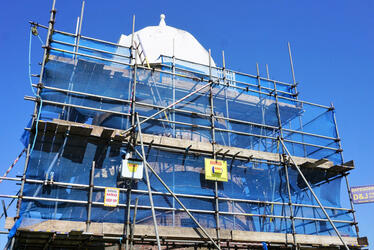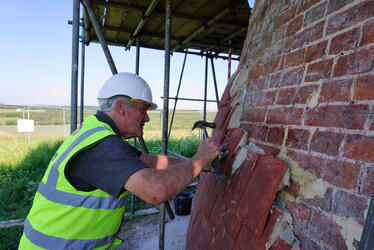CASE STUDY
Halnaker Windmill Refurbishment, Chichester 2017
Award-Winning Sympathetic Refurbishment of a Grade II Listed Windmill on the Site of a Scheduled Ancient Monument
-
“It's great to see a local authority in these times of financial austerity, delivering the sensitive restoration of this iconic, historic structure, making use of oast house tiles, hand-made in Sussex ... Frank Sayers received the judges' special commendation ... The judges in particular wanted to highlight the outstanding tiling”
- Judges, English Heritage Awards 2019 -
“This iconic Sussex landmark can once again be seen for miles around in its full glory ... I would like to thank our team at West Sussex County Council, as well as all the contractors involved in the restoration, who have worked so hard to bring this project to fruition.”
- Jeremy Hunt, Cabinet Member for Finance, WSCC -
“A lot of hard work and effort has gone into the restoration of the windmill and this could not have been achieved without the dedicated work of council staff, and local contractors..”
- Deborah Urquhart, Cabinet Member for Environment WSCC
Contract Value:£137 000
Completion: Sep 2017
Budget: Delivered to budget
Time: Delivered on time
Safety: Zero incidents
Description
To restore the external façade of a Grade II listed windmill in Halnaker, Chichester, in partnership with Surrey-based architects Brody Plant Goddard. The façade has a burnt Sussex clay tile hung finish with mortar torching underneath secured to the main brick structure. Tiles had become unsecured and dangerous, forcing this beautiful landmark to be encased behind heras fencing for public safety.
Restoration of the façade would allow future generations to enjoy this beautiful part of Sussex heritage safely.
Key Challenges
Protection of the building's heritage status as both a Grade II listed building, and being part of a Scheduled Ancient Monument due to being situated on a Neolithic Causewayed Enclosure, a historic post mill, and Second World War Radio Direction Finding (RDF) towers.
- Sympathetic repair: The tile size, banding and colour, fixing details and lime mortar repairs all had to be sympathetic to the original construction techniques. Equally, the repair of the brick structure beneath the tiling, although concealed from view, had to be undertaken in a traditional manner. Poor quality repairs from previous decades also needed to be corrected.
- Respect for the area: There was no vehicular access to the windmill, and as part of a Scheduled Ancient Monument, options for creating temporary transport links were limited. Vehicle parking was restricted to the public car park some distance away. To transport materials from the car park to the windmill, while being sympathetic to the protected nature of the site, a temporary track was laid down with a lightweight Cross Terrain vehicle acting as a shuttle between the car park and the windmill itself. Furthermore, the access route crossed private land which meant negotiating with the local farmer to ensure that unrestricted access was available.
Works in a weather-exposed location, especially due to temperature requirements for lime mortar use.
- Careful scheduling enabled us to perform the works during the summer months. Tight control of project deadlines and milestones was a must, and as much as the work was carried out off-site as possible.
Protecting an ecologically significant site
- Chalk grassland and swallow nesting sites all needed to be protected during the works. The use of a temporary, soil-protecting track, along with a light-weight utility vehicle for travel and deliveries ensured the grassland was protected and suffered no long-term damage.
- The use of natural materials significantly reduced environmental impact, including the use of hand made clay tiles and lime mortar, which reduced impact from modern manufacturing techniques.
Completion on-time and on-budget.
- Regular cost reports kept the client apprised of the financial position of the project, and extras were clearly costed and documented to ensure no overruns.

























